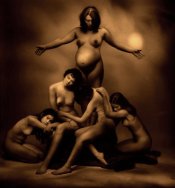jovo said:
Thanks for asking. The original source of my statement is long since forgotten, but I googled "pitch intervals and universal meaning" and chose the following:
www.lotpublications.nl/ publish/articles/001163/bookpart.pdf
It seems to relate well to my point, but is much more recent than what I was citing. In any case, it does seem to maintain, though with many equivocations, what I said. (I am by no means a scholar, rather, I'm a practicing cellist and teacher.)
Were such elemental 'cues' present in visual matters, then Donald's point might have some empirical validity beyond being a hoped for notion.
Well, I hate to break the news to you, but you haven't read the thesis carefully. Take the main point:
"This thesis investigated how universal the paralinguistic signalling of
intonation is by examining the perception of meanings deriving from the biological codes."
* This thesis studies intonations, also called more specifically
contours, which are much, much different from
phonemes. Mark the use of the word "paralinguistic". I will use the word "contour" here because it is a more precise term than "intonation".
* A countour is the general movement of tone over a word. For example, it's like saying "Really?" versus "Really!". In the first case, you raise the tone slightly at the end of the word, in the second one you drop it. That change of tonality carries a meaningful information, here interrogation versus affirmation.
* Yet contour are not phonemes, because they do not determine whether you're saying "hat" or "hot". The definition of a phoneme is roughly: a minimal utterable sound that will alter the meaning of a word if it is changed. Because of its impact on meaning, early linguist believed that there was an essential relationship between each phonemes and the meanign of the word carrying them. It was Saussure's insight that we must not look at the relationship between a phoneme and meaning, but rather look at the system (the
structure of a language) to understand the formation of meaning. Language is a "play of difference", and it is because "a" does not sound like "o" that "hat" and "hot" are distinct. Not because "a" means "stuff that goes on the head" and "o" means "things that can burn".
* What I pointed out was that modern linguistics followed the track that
phonemes have no essential relationship to the meaning of the words they constitute. There used to be arguments in the 19thC that "liquid" vowels (like "l") would be related to water and words associated to it, among languages. THIS is the argument against which modern linguistics stands.
* The thesis you have brought out argues for the possibility of a universal relationship between countours and meanings, so that a rising contour is generally associated with interrogation &c. This is perfectly valid research and I think a great contribution, but in now way does it undermine the notion that phonemes and meaning of words are unrelated.
* Finally, lest this comes up, tonal languages like Mandarin have tones on each vowels, which participate in the determination of phonemes. In a language like English, it does not make a difference if I say "hAt" or "hAat" (I'm trying to imitate in writing a rising from a rise-fall tone!). But in Mandarin it does. Mandarin is pretty tough to pronounce for a non-tonal speaker because it feels like you're singing false, as the tones change from one vowel to another, just like vowels follow no predterminate order in a sentence. Yet Mandarin has also contours in addition to vowel tone, so that you can ask a question by raising the tone slightly at the end of a sentence. Pretty hard to do for a non-native speaker, but believe me, native speakers break no sweat on that.
So in conclusion, no there are no universal relationships between phonemes and meaning, while there can be patterns of meaning in contour. But even acoustically phonemes and contours are radically different beasts, so you can't jump from a conclusion about the one based on the other.






